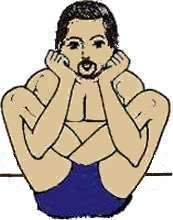| |
 |
apid |
Just what you need to know! |
| eview |
|

Basic Facts about the Yoga Posture (Asana)
The Womb Embryo Posture (whose original Indian name is Garbha Pindasana) in Yoga is suitable for reducing excess fat in the body especially in the abdominal region.
Note that Garbha means Womb, whereas Pinda means Embryo. The posture gets its name because the person performing it resembles a human fetus in the womb with some differences. Whereas the fetus has its legs above the head and the arms crossed, the person performing the Womb Embryo Posture (Garbha Pindasana) has the head above the legs and the arms parallel toward the ears. Further, unlike the fetus whose arms are not locked within the legs, the person in the Womb Embryo Pose (Garbha Pindasana) locks them by inserting the arms in the gaps between the calves and thighs.
Stepwise Technique

- Sit on the ground with your head and spine erect. Extend your legs forward such that the knees and heels are placed together. With the help of your hands, place your right foot on the left thigh and then your left foot on the right thigh. See the Lotus Posture (Padmasana) for more details.
- Pass your hands through the gap between the calves and the thighs close to your knees. Then, thrust your arms forward till the elbows.
- Breathe out and raise your thighs off the ground. Bend your arms at the elbows and then hold your ears with your hands. Carefully balance your body weight on the tail bone (coccyx).
- Breathe normally and maintain this final position for about 10 seconds (in the early stages) to 30 seconds or your breakpoint*.
Tips and Comments
- Step 1 may be alternatively performed by placing your left foot first on the right thigh and then your right foot on the left thigh. Repeating the yoga posture by switching the crossing of the feet ensures that both legs are built uniformly.
- Overweight people may find it relatively hard to pass their arms through the gap between their calves and their thighs. However, the arms can be more readily passed through the gap if one raises oneself a bit just after Step 1.
- The Womb Embryo Pose (Garbha Pindasana) is a variation of the Lotus Posture (Padmasana or Kamalasana). If you encounter difficulties in performing Step 1 starting with the Lotus Posture (Padmasana), attempt with the Half Lotus Posture (Ardha Padmasana) initially. Later, switch over to the Lotus Posture.
- *Breakpoint is the time upto which you can comfortably remain in a yoga posture. It varies from individual to individual depending on one's fitness, age and will power.
Potential Benefits of the Yoga Posture (Asana)
- The Womb Embryo Posture (Garbha Pindasana) is believed to help in a spiritual union between one's mind and soul.
- The abdomen remains shapely and slim due to total contraction during the posture.
- The digestive system of the body improves due to the regular practice of this posture It also treats all kinds of stomach illnesses.
- The yoga posture provides exercise to both the upper and the lower body of the performer.
Disclaimer : Syvum makes no representations or warranties of any kind, express or implied, as to the correctness of the content as well as the accuracy and use of the information regarding the practice of Yoga. It is strongly advised that you consult your physician before engaging in any physical activities. The information herein is not intended to substitute professional medical opinion or qualified Yoga instructors' opinion. To the full extent permissible by applicable law, Syvum disclaims all warranties, express or implied, including but not limited to, implied warranties and fitness for a particular purpose. Syvum will not be liable for any damages of any kind arising from the use of the information regarding the practice of Yoga, including but not limited to direct, indirect, incidental, punitive and consequential damages.
|
|

